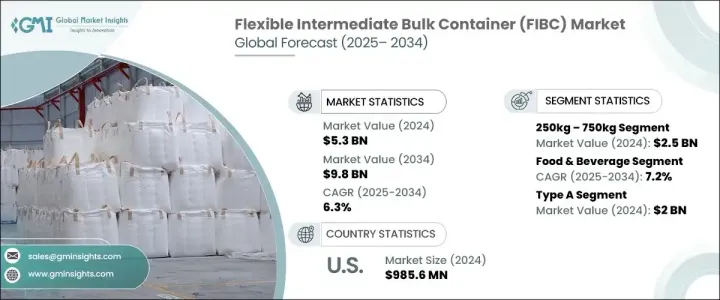
FIBC(Flexible Intermediate Bulk Container) 세계 시장은 2024년 53억 달러로 평가되었고, 2025년부터 2034년까지 연평균 6.3% 성장할 것으로 예측됩니다.
제약, 식음료, 화학, 농업, 건설 및 기타 산업 분야 수요 증가가 이러한 성장에 박차를 가하고 있습니다. 이러한 컨테이너는 벌크 자재 취급을 위한 비용 효율적이고 내구성이 뛰어나며 가벼운 솔루션을 제공하기 때문에 여러 분야에서 선호되는 선택이 되고 있습니다. 또한, 세계 무역의 급격한 증가, 산업화의 발전, 엄격한 포장 규제가 시장 성장에 크게 기여하고 있습니다.

세계 기업들이 효율성과 지속가능성을 중시하는 가운데, FIBC는 환경 친화적 특성, 재사용 가능성, 국제 포장 표준에 부합하는 특성으로 인해 선호도가 높아지고 있습니다. 특히 선진국에서 지속 가능한 벌크 포장에 대한 선호도가 높아지면서 시장 확대에 더욱 박차를 가하고 있으며, 온라인 소매업체와 물류업체들이 비용 효율적이고 안전한 벌크 운송을 위해 FIBC를 채택하는 사례가 증가하면서 전자상거래의 부상도 중요한 역할을 하고 있습니다. 중요한 역할을 하고 있습니다. 제약 및 식품 가공 등의 분야에서 FIBC는 오염 없는 보관 및 운송을 보장하고 엄격한 위생 및 안전 규정을 준수합니다. 또한 내습성, 자외선 차단, 정전기 방지 가방 등 FIBC 기술의 끊임없는 혁신으로 다양한 산업 요구에 대한 적응성이 높아지고 있습니다.
| 시장 범위 | |
|---|---|
| 시작 연도 | 2024년 |
| 예측 연도 | 2025-2034년 |
| 시작 금액 | 53억 달러 |
| 예상 금액 | 98억 달러 |
| CAGR | 6.3% |
250kg-750kg 부문은 2024년 25억 달러의 매출을 창출했으며, 주로 농업, 식품 가공, 건설 등 중규모 산업을 대상으로 합니다. 이러한 컨테이너는 대량의 상품을 취급하는 비용 효율적인 솔루션을 제공하는 동시에 인건비를 절감하고 운영 효율성을 향상시킵니다. 위생적이고 무공해 포장에 대한 수요는 특히 안전과 규정 준수가 최우선 순위인 식품, 화학, 제약 등 다양한 산업에서 증가하고 있습니다. 이러한 분야에서 첨단 벌크 패키징 솔루션의 채택이 증가함에 따라 향후 10년간 이 부문의 성장세가 유지될 것으로 예측됩니다.
주요 응용 분야 중 식음료 산업은 가장 빠르게 성장하는 분야로, 2025년부터 2034년까지 연평균 7.2%의 성장률을 보일 것으로 예측됩니다. 위생적인 식품 포장에 대한 정부의 규제 강화와 곡물, 콩류 및 기타 식품에 대한 세계 거래 증가가 이러한 성장을 주도하고 있습니다. 신뢰할 수 있는 대용량 벌크 포장 솔루션에 대한 요구가 식품 부문에서 FIBC에 대한 수요 증가로 이어지고 있습니다. 또한, 변조 방지, 내습성, 자외선 차단 옵션 등 FIBC의 소재 및 설계의 발전은 장거리 운송 중 제품의 무결성을 보장하는 등 FIBC의 매력을 더욱 높이고 있습니다.
미국의 FIBC(Flexible Intermediate Bulk Container) 시장은 제약, 식품, 화학 산업의 강력한 수요에 힘입어 2024년 9억 8,560만 달러 규모 시장을 창출했습니다. 지속가능성에 대한 규제 강화와 더불어 비용 효율적이고 친환경적인 패키징 솔루션으로의 전환이 가속화되면서 시장 성장을 견인하고 있습니다. 미국 내 기업들은 효율적인 자재 취급을 우선시하고 있으며, FIBC는 운영 비용을 절감하고 생산성을 향상시킬 수 있는 좋은 대안으로 떠오르고 있습니다. 식품 가공, 제약, 화학 등의 산업에서 지속 가능하고 위생적인 포장에 대한 관심이 높아짐에 따라 벌크 식품 용기에 대한 수요가 더욱 증가하고 있습니다.
The Global Flexible Intermediate Bulk Container Market was valued at USD 5.3 billion in 2024 and is projected to grow at a CAGR of 6.3% between 2025 and 2034. The increasing demand from industries such as pharmaceuticals, food and beverage, chemicals, agriculture, and construction is fueling this expansion. These containers offer cost-effective, durable, and lightweight solutions for bulk material handling, making them a preferred choice across multiple sectors. Additionally, the surge in global trade, rising industrialization, and stringent packaging regulations have significantly contributed to the market's growth.

As businesses worldwide continue to emphasize efficiency and sustainability, FIBCs are gaining traction due to their eco-friendly properties, reusability, and compliance with international packaging standards. The growing preference for sustainable bulk packaging, particularly in developed regions, is further supporting market expansion. The rise of e-commerce has also played a pivotal role as online retailers and logistics companies increasingly adopt FIBCs for cost-effective and secure bulk transportation. In sectors such as pharmaceuticals and food processing, these containers ensure contamination-free storage and transit, adhering to strict hygiene and safety regulations. Moreover, continuous innovations in FIBC technology, including moisture-resistant, UV-protected, and anti-static bags, are making them more adaptable to diverse industrial needs.
| Market Scope | |
|---|---|
| Start Year | 2024 |
| Forecast Year | 2025-2034 |
| Start Value | $5.3 Billion |
| Forecast Value | $9.8 Billion |
| CAGR | 6.3% |
The 250kg-750kg segment generated USD 2.5 billion in 2024, primarily catering to medium-sized industries such as agriculture, food processing, and construction. These containers provide a cost-efficient solution for handling large volumes of goods while reducing labor costs and improving operational efficiency. The demand for hygienic and contamination-free packaging is growing across various industries, particularly in food, chemicals, and pharmaceuticals, where safety and regulatory compliance are paramount. The increasing adoption of advanced bulk packaging solutions in these sectors is expected to sustain the segment's upward trajectory over the coming decade.
Among the key application areas, the food and beverage industry stands out as the fastest-growing segment, anticipated to expand at a CAGR of 7.2% from 2025 to 2034. Stricter government regulations regarding hygienic food packaging, coupled with the rising global trade of grains, pulses, and other food commodities, are driving this growth. The need for reliable and large-capacity bulk packaging solutions has led to an increased demand for FIBCs in the food sector. Furthermore, advancements in FIBC materials and designs, including tamper-proof, moisture-resistant, and UV-shielded options, are enhancing their appeal, ensuring product integrity during long-distance transportation.
The United States Flexible Intermediate Bulk Container (FIBC) Market generated USD 985.6 million in 2024, driven by robust demand from the pharmaceutical, food, and chemical industries. Stricter sustainability regulations, coupled with an increasing shift toward cost-effective and environmentally friendly packaging solutions, are propelling market growth. Businesses across the U.S. are prioritizing efficient material handling, with FIBCs emerging as a preferred choice for reducing operational costs and improving productivity. The heightened focus on sustainable and hygienic packaging in industries such as food processing, pharmaceuticals, and chemicals has further strengthened the demand for these bulk containers, positioning the market for steady expansion in the years ahead.